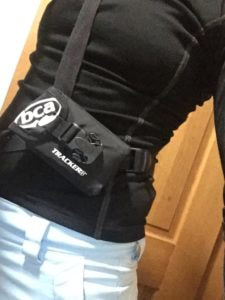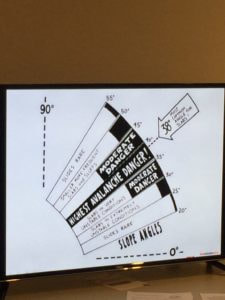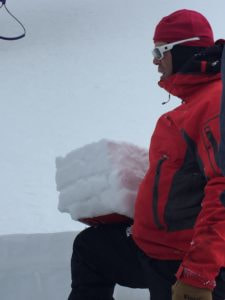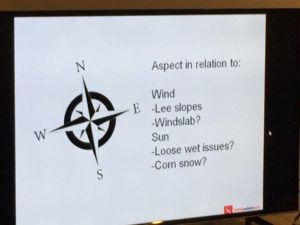|
My brain is reeling so fast, I can’t decide whether to panic. I can’t process it. My midriff is freezing from the force of the snow and there’s a sharp pain in my shoulder. My mind must be playing tricks on me, it’s like someone knocking on a door. My ragged breath is all I hear against very unnatural silence. Something hard like metal crunches against my jacket, I feel gloved hands scrabbling at my face and down my leg. A voice yells, “It’s okay, we’ve got you”. I feel chilly fingers jerk my jaw down and scrape snow from my mouth allowing my airway to suck gratefully at mountain oxygen. My goggles are pushed back and I look up to see my friend’s face, panting with exertion and concern. Behind her, two others use metal snow shovels to dig the rest of me out. “It was an avalanche, helicopter is on its way”, I’m told. What felt like an hour has taken just six minutes. Fourteen minutes is all rescuers have in an avalanche to give the victim a 90% chance at survival. To have a 50% of survival a victim is found and dug out within 30 minutes. To make the fourteen minute deadline, rescuers have seven minutes to locate the body and another seven minutes to dig them out to access oxygen. I was lucky to be found and dug out in six minutes, I’m told later over a cold beer in the pub. I’m grateful, but somehow not surprised. Luck played no part in being with this group of like-minded skiers, we deliberately sought out industry leading avalanche awareness training that provided on-mountain rescue scenarios and all carry rescue equipment in the mountains like second skin. A backpack filled with probe sticks, sturdy metal shovel, water, first aid and an avalanche beacon strapped to each skiers’ chest, set on ‘receive’ mode but all trained to flick the switch to ‘search’ mode if and when disaster strikes. This scenario is fictitious but it’s typical of situations that not only can happen but frequently do. In the 2015/16 winter season the USA experienced 29 fatalities in a typical winter season with an average of 27 deaths. Numbers are similar for Canada at 32 deaths. It’s no surprise avalanche fatality statistics in Japan are more difficult to source online. Recreational snow sports have grown in popularity since the 1950s, but snow resorts enjoyed mostly by Japanese people are experiencing boom international growth, international visitor demand can often outstrip services such as adequate ski patrol and lift operation in many resorts, some resorts have rules forbidding ski patrol to search or collect the victim until they are dragged back inside the resort boundary by their friends. At least one resort is famous for their lift operators to go to lunch for an hour, leaving skiers and boarders to load themselves on and off chairlifts until they return. Humans by our very nature like to push the boundaries. Civilisations have flourished across continents on the backs of intrepid individuals brave enough to search for more. International snow resorts enjoy popularity with Australian snowsport enthusiasts in the pursuit of value for money, great terrain and cultural experiences they can’t get back home. The lure of ‘off-piste’ skiing is real and accessible for Australians, professional skiers and snowboarders flaunt magazines, tv shows and ski movies making international mountains look appealing. If the desire and funds for the trip is available, there is little else standing in the way of an advanced National Geographic reports that 90% of avalanche incidents are triggered by the victim or someone in their group. The worldwide statistics for fatalities sits at 150, these are just the incidents reported, the majority of victims are skiers, snowboarders and snowmobile riders. Avalanche Safety Training Level 1 is an introductory avalanche awareness course developed by Avalanche Canada (formerly called the Canadian Avalanche Centre). It is designed to give people an entry level avalanche decision making framework for using unpatrolled snow areas for recreation. It is internationally recognised and regarded as world standard. To have each of your ski party equipped with this qualification is no guarantee of absolute safety but means everyone is trained to search for a victim’s avalanche beacon in a globally standardised way and knows the timeframes to work under. There is a tried and tested method for using the avalanche beacon and a structure for best case scenario rescue. Each person gains decision making competence, gains experience assessing a variety of terrain and performs at least one mock rescue involving one to four avalanche victims somewhere high on an isolated mountain with the only way home to ski down or emergency helicopter out. Wearing and carrying proper gear is paramount to comfort out on a mountain. It’s great to save money but when you’re out in extreme elements in side or back country it’s no time to skimp on quality. Le Bent, an innovative Australian base layer company has combined the benefits of bamboo with merino wool to produce base layer tops, pants, socks, balaclavas and gloves for snow conditions . Hiking 8 km straight up the ridge from the base of the mountain ready to ski untracked powder in the NSW Snowies, the merits of this unusual bamboo-merino combo is noted and appreciated. A former user of synthetic balaclavas, the breathability of bamboo made hiking bearable, hours later when wind whipped sideways and snow swirled, those perspiration-wicking base layers really counted. The Le Bent socks with added shin layer bore the brunt of every step my cross-country skis took. And the odour-free properties were true to form. Quality boots, snow jacket and pants help with success of being out in mountainous conditions for long periods of time. Weather can change in two seconds from sunny to inclement gale, The joke of the day during my avalanche awareness course was the coffee van is right around the corner. The reality is far from that. If things go wrong with boots, socks balaclava or skis it’s a long day ahead of discomfort with blisters, extreme cold or risk of a broken ankle. You are 90% more likely to come home if there is a
female in your group. Women are more risk averse, encourage like-minded female friends to join your group rather than dissuade them based on gender alone. If you’re thinking of pushing personal limits beyond the confines of snow resorts, first think Avalanche Awareness and make your best chance of success your smartest one you’ve made all year.
0 Comments
Leave a Reply. |
Archives
March 2022
AuthorSnow Safety Australia is a NSW based information website. Categories |
Training Courses |
Company |
|













 RSS Feed
RSS Feed